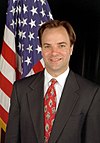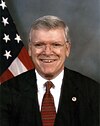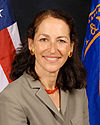Food and Drug Administration
|
|||
|---|---|---|---|

|
|||
| State level | Federation | ||
| Supervisory authority (s) | Ministry of Health ( United States Department of Health and Human Services ) | ||
| Consist | since 1927 | ||
| Headquarters |
Silver Spring , Maryland , United States |
||
| FDA Commissioner | Stephen Hahn | ||
| Employee | approx. 13,500 (2012) | ||
| Website | www.fda.gov | ||
The US Food and Drug Administration ( FDA , German authority for food and drugs ) is the food control and drug authority of the United States . As such, it reports to the US Department of Health . The FDA was 1927 founded and its registered office is in Silver Spring ( Maryland , USA). The current head of the agency (FDA Commissioner) is Scott Gottlieb . There are four directors responsible for the main duties of the agency.
Your job is to protect public health in the United States . The FDA controls the safety and efficacy of human and veterinary medicinal products , biological products, medical products , foods and radiation-emitting devices. This applies to both US-made and imported products.
All drugs approved in the USA must be manufactured by pharmaceutical manufacturers who have been inspected by the FDA and whose manufacturing facilities comply with the regulations. The same applies to manufacturers of medical devices.
history
The establishment and growth of an agency for the purpose of consumer protection in drug use should be seen in the context of various legislative responses to drug incidents , in particular the diphtheria antitoxin incident of 1901, the sulfanilamide disaster of 1937 and the thalidomide incident of 1960.
1901 ill a horse named Jim whose blood serum in the US for the production of anti- diphtheria - antisera was used to tetanus . Shortly afterwards, 13 children died of tetanus. The Woman's Christian Temperance Union then launched a public campaign to create a law against food contamination and medicines in use at the time. On July 1, 1902, the Biologics Control Act was signed.
In 1906, President Theodore Roosevelt signed the Pure Food and Drug Act (or Wiley Act ), which prohibited the movement of adulterated food or pharmaceuticals between states. The Bureau of Chemistry was responsible for monitoring ; this was subordinate to the Ministry of Agriculture . In 1927, the oversight function of the Bureau of Chemistry was merged into a new agency, the Food, Drug, and Insecticide Administration , which was renamed the Food and Drug Administration (FDA) in 1930 .
The sulfanilamide disaster led to the passage of the Food, Drug, and Cosmetic Act in 1938, which required pre-market testing of drugs, banned misleading therapeutic claims, and gave the FDA far-reaching powers of intervention. To date, this law is the basis of most FDA regulations.
After the thalidomide scandal , the Food, Drug, and Cosmetic Act 1962 was expanded to include the Kefauver Harris Amendment , which obliges pharmaceutical companies to prove the efficacy and safety of new drugs.
In February 2020 (at the time the danger of the COVID-19 pandemic in the United States was not yet recognized and Trump had repeatedly claimed it was under control ) Stephen Hahn, the head of the FDA, put rules into force that paradoxically hospitals, Private clinics and companies made it difficult to use diagnostic tests (e.g. COVID-19 tests) in emergencies. At that time, other countries were already doing tens of thousands of tests a day, in the USA it was fewer than 100 a day. At the end of February 2020, rules were relaxed.
Task of the FDA
The FDA is also responsible for improving public health. This happens u. a. by supporting or accelerating innovations that can make pharmaceuticals and foods more effective, safer and more affordable. Through accelerated approval procedures, new types of drugs can be made accessible to patients more quickly. B. to be able to better treat previously untreated diseases. While supporting independent experts , the FDA in the decision on the approval or rejection of new drugs. The FDA also publishes accurate, scientifically based information about the use of drugs and foods to improve overall health. In view of the limited meaningful information on drug safety at the time of approval, despite the considerable research effort, some scientists suggested that the approval system be redesigned: A combination of more frequent conditional approvals and improved independent drug monitoring after approval should lead to better drug safety overall.
Food supplements
In 1994 the Dietary Supplement Health and Education Act (DSHEA) was passed. This regulates the classification of certain dietary supplements as food and not as pharmaceuticals . Because of this, they no longer need to be approved by the FDA. Today, a dietary supplement must first be considered harmful before the FDA can intervene.
organization
The four directors are responsible for the following main tasks:
- Medical Products and Tobacco
- Foods
- Global Regulatory Operations and Policy
- Operations (enforcement and organizational matters)
The FDA has numerous departments, centers, and offices that report either directly to the management or to one of the four directors. This includes:
- Office of the Commissioner (OC)
- National Center for Toxicological Research (NCTR, National Center for Toxicological Research)
- Center for Food Safety and Applied Nutrition (CFSAN, Center for Food Safety and Applied Nutrition )
- Center for Veterinary Medicine (CVM, Center for Veterinary Medicine )
- Office of Regulatory Affairs (ORA)
- Center for Biologics Evaluation and Research (CBER, Center for Biologics Evaluation and Research)
- Center for Devices and Radiological Health (CDRH, Center for Medical Devices and Radiation Safety Compliance)
- Center for Drug Evaluation and Research (CDER, Center for Drug Evaluation and Research)
Head of Authority
Walter Gilbert Campbell , who held office from 1921 to 1924 and 1927-1944, was the long-standing director during the founding period .
| Surname | image | Appointed | Dismiss | Acting President |
|---|---|---|---|---|
| Donald Kennedy |

|
1977 | 1979 | Jimmy Carter |
| David Aaron Kessler |

|
November 8, 1990 | February 28, 1997 | George HW Bush |
| Jane E. Henney | January 17, 1999 | January 19, 2001 | Bill Clinton | |
| Mark McClellan |

|
November 14, 2002 | March 26, 2004 | George W. Bush |
| Lester Crawford |

|
July 18, 2005 | September 23, 2005 | George W. Bush |
| Andrew von Eschenbach |

|
December 13, 2006 | January 20, 2009 | George W. Bush |
| Margaret Hamburg |

|
May 22, 2009 | April 1, 2015 | Barack Obama |
| Stephen Ostroff |

|
February 2015 | January 2016 | Barack Obama |
| Robert Califf |

|
February 2016 | May 2017 | Barack Obama |
| Scott Gottlieb |

|
May 2017 | Donald Trump |
Web links
- Official website of the Food and Drug Administration
Individual evidence
- ^ Food and Drug Administration: Distribution of Full Time Equivalent (FTE) Employment by Program . Accessed March 5, 2014 (PDF, 469 kB).
- ^ Meet Scott Gottlieb, MD, Commissioner of Food and Drugs
- ↑ a b FDA Organization , accessed July 31, 2017.
- ↑ a b c Ronald Hamowy: Medical Disasters and the Growth of the FDA . Independent Policy Reports, The Independent Institute, 2010 ( PDF ).
- ^ 57th Congress , Session 1, Chapter 1378 , 1902 ( PDF ).
- ^ Centennial of FDA
- ^ The Kefauver-Harris Amendments .
- ^ Editing of Trump statements ).
- ↑ The lost month: How a failure to test blinded the US to Covid-19 nytimes.com of March 28, 2020
- ^ Curt D. Furberg, Arthur A. Levin, Peter A. Gross: The FDA and Drug Safety . In: Archives of Internal Medicine . tape 166 , no. 18 , October 9, 2006, pp. 1938–1942 , doi : 10.1001 / archinte.166.18.1938 .
- ↑ US Dietary Supplement Health and Education Act of 1994